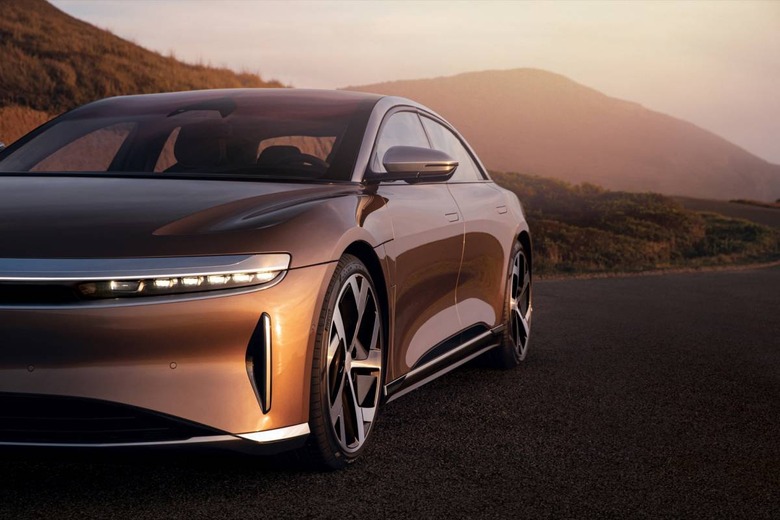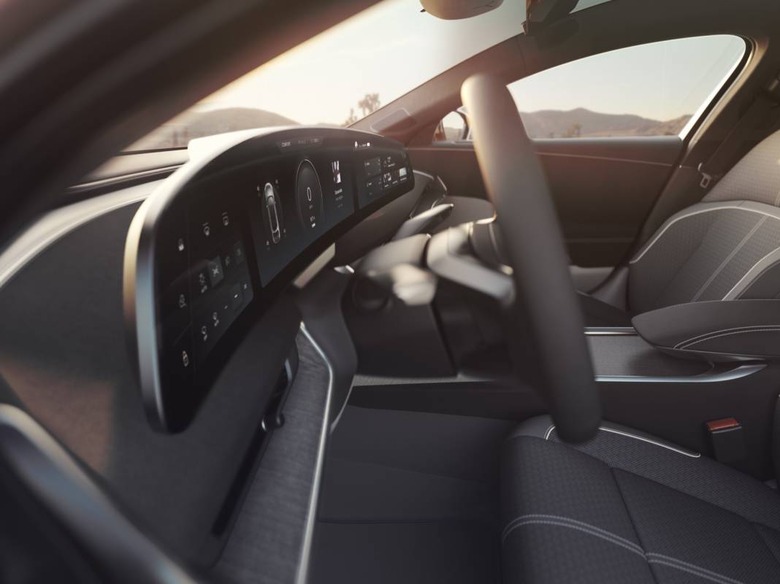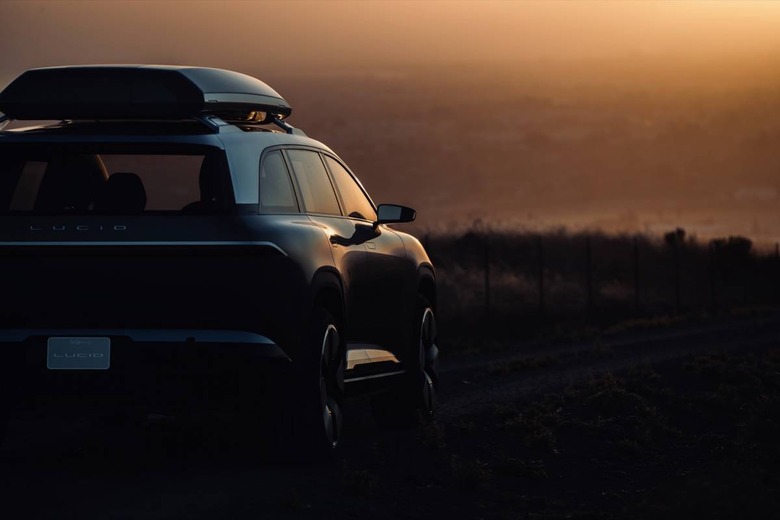Lucid Motors' Design Chief Explains The Electric Air's Toughest Challenge
Designing concept cars is easy. Designing a car that can actually make it into mass production, at a competitive price, and take on both auto industry heavyweights and high-profile disruptors, well, that's a whole other story. With the 2021 Lucid Air finally revealed in road-going form, I caught up with Derek Jenkins, VP of Design at Lucid Motors, to find out why a sedan, why all-electric, and what sets this particular EV apart.
Jenkins is no stranger to the auto industry. When he joined Lucid in mid-2015, eighteen months before the concept Air was first revealed, it was after more than six years as Director of Design for Mazda North America. That role had followed nine years as Chief Designer for Volkswagen of America, and seven years before that at Audi.

Lucid Air, though, doesn't look like anything from Jenkins' pen before, something the design chief says was by intent. What follows has been edited for clarity and length.
Derek Jenkins: In many ways the sedan as a vehicle format hasn't really evolved much. If you think of the generations of well-known sedan – think of [BMW] 5 Series or a [Mercedes] E-Class – think of five generations of how it's evolved, it's relatively linear. I think that's because the architecture for a sedan hasn't really changed in about 45 years.
Occupants go here, trunk goes here. Maybe the whole thing scales up over time, but it scales up proportionally.
Chris Davies: It sounds like it was a conscious decision by Lucid to go for a sedan, then?
Obviously we had a ton of discussion about this, dating all the way back to 2015 and 2016, as to which was the best format. We continued to land on the sedan because the format is inherently more efficient from a weight and from an aero standpoint.

Some electric vehicles intentionally opt for more striking, almost controversial styling, because it's easier to stand out that way. The Air doesn't really look like anything else on the market right now, but it's also not aggressively outlandish either.
As a designer, we labor over this discussion. Doing something outrageous and different is easy, actually. Doing it, so it appeals to a lot of people, yet doesn't look like everything else, that's really hard.
In our case, I wanted to make sure the design was pure and relatively honest – it didn't feel hyper-stylized. I wanted it to be very clean, very minimalistic.
I didn't want to have a potential customer be blown away by the performance and everything it can do, but feel, "ugh, I have to explain this to my neighbors."

What do you see as some of the key hallmarks of electrification that Air embraces?
The face of the vehicle is comprised primarily from two parameters. The first is lighting, so we have incredible lighting technology, it's very high tech, it's minimalist, and very efficient.
The second is how we're handling aerodynamics, and our thermal cooling. As you know, electric vehicles still need some thermal management and cooling, but relative to internal combustion it's relatively small. So we worked hard to minimize the front openings to the very smallest area.
You don't need a traditional grille, and we're taking the approach that really a traditional grille is going to be seen as old-fashioned in the next few years.

Inside, you've made a big point of how you're taking full advantage of this new electric architecture to maximize internal space. S-Class room in a footprint smaller than a Model S or a Taycan. Can you talk about how you communicate luxury when you're building a new electric vehicle?
The topic of "what is luxury in the past, today, and in the future" is a topic we constantly dwell on, and how we can better define where it is going in the future. [The current view of luxury], all that's gone through a pretty dramatic revolution, even in the past ten years ... toward technology, human experience, sustainability.

The aesthetic of luxury has become more minimalist, a little bit more approachable, and less opulent, but still very much rewarding from an experiential standpoint. It was more about stripping [brightwork and detail] away, and just putting select areas of quality and material.
We really tried to give a feeling of minimalism, yet high quality, warm, and tactile.
Some electric, or electrified, vehicles make a big show of their electrification, giving you graphics of where the power is flowing from and to, lots of displays and icons. What were some of the design considerations for what the driver sees from behind the wheel?
It was more about opening everything out, a very digital experience, but I didn't want the digital experience to be traditional or too many symbols of old gauges. It's more aligned with digital devices in our lives, with respect to windows and tabs.

We wanted to keep the emotion, so I was always trying to balance on the user experience this idea of heart and mind. We use it as a filter for Lucid design ... It has to be technical but also emotional.
The aesthetic of luxury is very established. Were you ever tempted to push the envelope much further with Air's design, but perhaps tempered that because of the expectations of the segment?
I felt like, when I very first started on the project, will people think a car without a big chrome grille and a symbol on the front is expensive? Will people think that not having a big, long hood no longer expresses power, or prestige?
We struggled with that, to be totally honest. At a certain point I just had to rely on good design principles of form and function. If, in ten years, most things are electric, all the old symbols and proportions will be seen as old-fashioned.

Part of the challenge with a luxury car is that the usual target demographic skews older. How did the need to appeal to that audience help shape the Air's design?
There's a certain price of entry for this segment of cars, this luxury – top-line luxury – sedan segment. Traditionally speaking there's a certain age bracket there. It tends to lean toward an older customer.
That said, we looked at it and said, if we can be the most progressive vehicle in that segment, it's also going to attract a younger consumer who has the means. Our performance will be the best of the segment, it will be loaded with technology ... it inherently attracts the younger customer, the early-adopter.

If we've offered the most progressive vehicle in that class, I still think we have the opportunity to attract the older consumers who maybe wouldn't have considered an EV. At the same time, being the most advanced vehicle in the segment, or potentially in the market, I think will draw up the younger, affluent consumers to that product.
One of the things Lucid Motors has emphasized is that this isn't just about Air, but about the platform, the architecture of the car. Something you'll be using for future vehicles. What can you tell me about that?
Obviously we have a very unique situation here ... because we're really starting clean sheet, legacy is not an obstacle for us, so we can really concentrate on the future and how our brand can best define that future.
We've already created a plan for the Lucid Air platform, but the second platform and even the third platform as we look 10 years into the future. There's a path, a road, we see ourselves accelerating on.

You've already confirmed that the second Lucid model will be an SUV, or a crossover.
We've developed early versions of that vehicle in conjunction to Lucid Air. It will stay true to all of the values of efficiency, and performance, and usability, and future-facing luxury aesthetic.
I see an opportunity to really optimize efficiency, and space, and performance in that luxury crossover, that luxury SUV space. It's a more progressive space than the sedan market, and I'm very excited about it.
